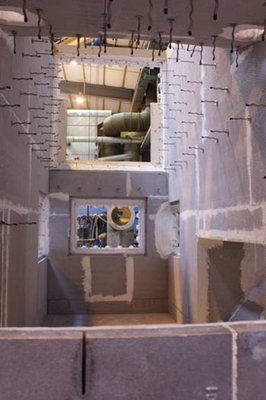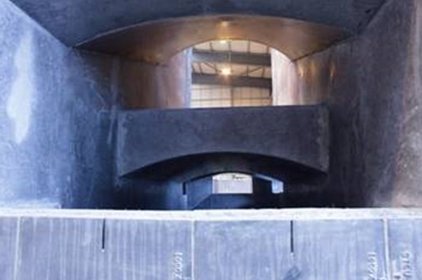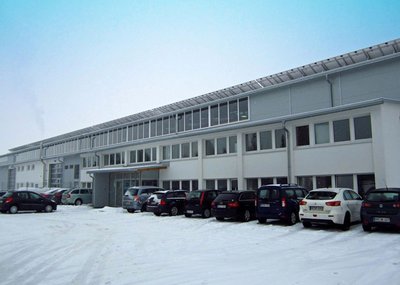 Hot goods in aluminium
Hot goods in aluminium
Whether foil packaging or car body part – aluminium is indispensable as a light metal in many production sectors and branches of industry, despite new materials such as carbon fibre reinforced plastics. Efficient processing of aluminium is ensured by special, energy-saving melting furnaces for instance those produced at ZPF GmbH, located in the German federal state of Baden-Württemberg.  A somewhat bigger slug
A somewhat bigger slug
The raw steel casing for the furnace to be built marks the beginning of each production order at ZPF. Despite the huge dimensions of the solid components, they only represent a quarter of the total weight of the finished melting plant. All the same, only nine tons – the net weight of the steel construction of a normal-sized furnace – call for transporting and lifting technology with adequate load capacities, right from the start. Complete value creation within our own company
Complete value creation within our own company
The sizing and aligning, insulation, lining, mounting, cabling and testing are carried out entirely at our own factory in Siegelsbach. The end results are melting furnaces which are delivered to the customer practically ready-for-operation, thus minimising expenditure for installation and commissioning at the operation site and preventing any production interruptions occurring at all.  Each furnace is made-to-measure
Each furnace is made-to-measure
The melting furnaces are made solely to order and in accordance with the individual requirements of our customers. In consequence, each furnace made by ZPF is a tailored product that complies strictly with the requirement of the ordering party. Nevertheless, customers normally only have to wait about fourteen weeks for "their" furnace, depending on the degree of capacity utilization and the scope of the project. Most of this time – namely around five weeks - is taken up with manufacturing the steel construction, while the remaining time is used for the lining and for the assembly of the various components and add-on parts.  Inside and outside insulation
Inside and outside insulation
One of the essential characteristics of ZPF furnaces is their energy efficiency which, to a large extent, is based on effective insulation:
In an initial step, the interior is coated with a layer of insulation material developed specifically for furnace construction, and then lined with special refractory concrete. This helps to keep the energy where it belongs - inside the furnace.
Not only do insulation and concreting render the melting process more efficient, they also reduce the outside temperature of the furnace housing, consequently lowering the level of heat stress for the employees working in the foundry.  Cost saving by intelligent geometry
Cost saving by intelligent geometry
The configuration of the refractory material – as well as the entire geometry of the interior – complies with a specific, flow-optimised design. As a result, the hot exhaust gases are not directly drawn into the chimney, but are initially kept in the furnace. In the process, the heat contributes to holding the aluminium at the desired pouring temperature. At the same time, most of the harmful substances contained are burnt by this heat, which is why the melting plant does not need any further filters. Optimum protection right into every last corner
Optimum protection right into every last corner
The outside of the melting furnace is coated with a protective paint finish which is not only intended for protecting the steel against corrosion, but also for keeping off environmental influences and for preserving both its clean appearance and the functionality of the shell in the long term.  Customization even during assembly
Customization even during assembly
A ZPF furnace is real precision work; everything must be in its place. The points for installing and fitting the burner, hydraulic system, door cylinders or simply the furnace ladders or grates are not chosen at random, but have their specific position, depending on the furnace type – everything is focused on ease of use and best possible performance. The same applies to electrical and electronic systems on and in the furnace. In this way, each furnace is precisely adapted to the requirements of the respective customer. At tipping point
At tipping point
The entire melting furnace - in this case with a weight of about 35 tons - is tipped in a controlled way to pour out the liquid aluminium. This concept is based on high-performance control technology capable of precisely controlling the movement, thus ensuring an absolutely safe process that complies with specifications. ZPF conduct various functional tests on each newly built furnace to ensure that operations also run as planned in practice.  Insulation multiplied by two
Insulation multiplied by two
Not only the interior, but other places as well, such as the area surrounding the pouring spout, are provided with individual insulation to ensure maximum efficiency. This involves the use of specific insulation material that features excellent refractory properties in addition to its insulating effect. Consequently, during the pouring process, the liquid aluminium virtually retains the temperature it has inside the furnace, thus facilitating further processing and reducing expenditure for the user.  Functional test prior to each delivery
Functional test prior to each delivery
ZPF melting furnaces can be charged using either forklifts or an attached, automated charging device. In either case, it is essential that the door of the charging hole opens reliably and closes tightly, which is the reason why this equipment is specially tested prior to delivery. Tightness is of particular importance for the quality of the melt, since aluminium reacts with oxygen to form unwanted corundum.
In addition to this, all electrical, electronic and safety-related elements are thoroughly tested to ensure that the customer receives a properly functioning furnace.  Turnkey ready and on the road
Turnkey ready and on the road
The finally assembled and tested, extremely heavy furnaces are loaded onto a heavy-duty low-bed truck at the ZPF premises and transported either directly to the foundry or to a harbour. Although most of our customers are located in Europe, many of our furnaces start on a long journey overseas.  Right of way for the furnace
Right of way for the furnace
The transportation from the small municipality of Siegelsbach is not always easy. Meanwhile, though, the local authorities have become accustomed to the heavy-duty trucks and the drivers know the special characteristics of the various routes from the ZPF site to the next available motorway. It may occasionally get quite complicated at the destination; but thanks to good preparation, rigorous project management and close communication it has always been possible to install each furnace at the desired location.
Partner
Foundry Corporate News
Topic Pressure Die Casting
ZPF Photo Story "A melting furnace in the making"
Lesedauer: min
[56]












